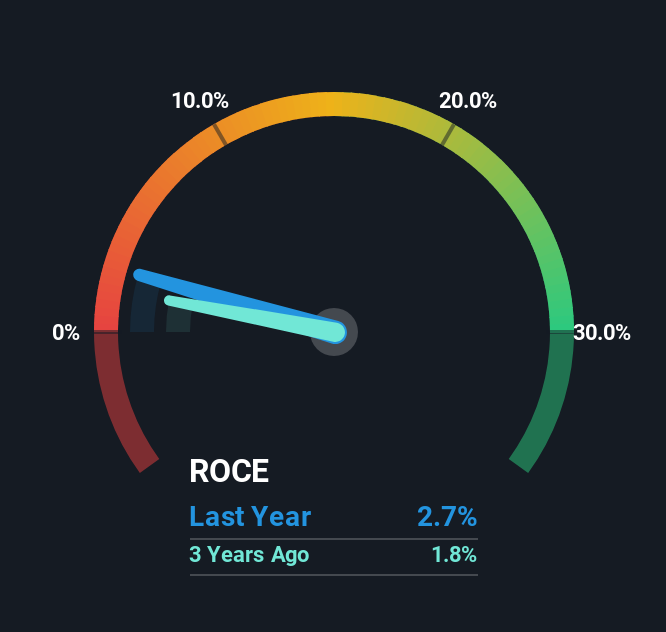When it comes to investing, there are some useful financial metrics that can warn us when a business is potentially in trouble. More often than not, we'll see a declining return on capital employed (ROCE) and a declining amount of capital employed. This indicates to us that the business is not only shrinking the size of its net assets, but its returns are falling as well. And from a first read, things don't look too good at Wooyang (KOSDAQ:103840), so let's see why.
Return On Capital Employed (ROCE): What Is It?
For those that aren't sure what ROCE is, it measures the amount of pre-tax profits a company can generate from the capital employed in its business. The formula for this calculation on Wooyang is:
Return on Capital Employed = Earnings Before Interest and Tax (EBIT) ÷ (Total Assets - Current Liabilities)
0.027 = ₩1.7b ÷ (₩151b - ₩88b) (Based on the trailing twelve months to June 2025).
Therefore, Wooyang has an ROCE of 2.7%. In absolute terms, that's a low return and it also under-performs the Food industry average of 7.0%.
View our latest analysis for Wooyang

Historical performance is a great place to start when researching a stock so above you can see the gauge for Wooyang's ROCE against it's prior returns. If you'd like to look at how Wooyang has performed in the past in other metrics, you can view this free graph of Wooyang's past earnings, revenue and cash flow.
What Does the ROCE Trend For Wooyang Tell Us?
In terms of Wooyang's historical ROCE movements, the trend doesn't inspire confidence. To be more specific, the ROCE was 12% five years ago, but since then it has dropped noticeably. Meanwhile, capital employed in the business has stayed roughly the flat over the period. This combination can be indicative of a mature business that still has areas to deploy capital, but the returns received aren't as high due potentially to new competition or smaller margins. If these trends continue, we wouldn't expect Wooyang to turn into a multi-bagger.
On a separate but related note, it's important to know that Wooyang has a current liabilities to total assets ratio of 59%, which we'd consider pretty high. This effectively means that suppliers (or short-term creditors) are funding a large portion of the business, so just be aware that this can introduce some elements of risk. Ideally we'd like to see this reduce as that would mean fewer obligations bearing risks.
In Conclusion...
In summary, it's unfortunate that Wooyang is generating lower returns from the same amount of capital. Long term shareholders who've owned the stock over the last five years have experienced a 13% depreciation in their investment, so it appears the market might not like these trends either. With underlying trends that aren't great in these areas, we'd consider looking elsewhere.
One more thing: We've identified 4 warning signs with Wooyang (at least 3 which are significant) , and understanding them would certainly be useful.
For those who like to invest in solid companies, check out this free list of companies with solid balance sheets and high returns on equity.
Valuation is complex, but we're here to simplify it.
Discover if Wooyang might be undervalued or overvalued with our detailed analysis, featuring fair value estimates, potential risks, dividends, insider trades, and its financial condition.
Access Free AnalysisHave feedback on this article? Concerned about the content? Get in touch with us directly. Alternatively, email editorial-team (at) simplywallst.com.
This article by Simply Wall St is general in nature. We provide commentary based on historical data and analyst forecasts only using an unbiased methodology and our articles are not intended to be financial advice. It does not constitute a recommendation to buy or sell any stock, and does not take account of your objectives, or your financial situation. We aim to bring you long-term focused analysis driven by fundamental data. Note that our analysis may not factor in the latest price-sensitive company announcements or qualitative material. Simply Wall St has no position in any stocks mentioned.
About KOSDAQ:A103840
Low risk and overvalued.
Market Insights
Community Narratives




